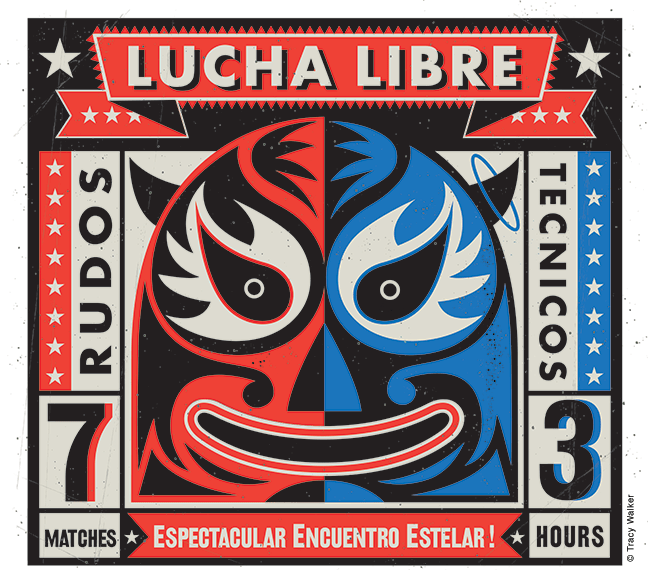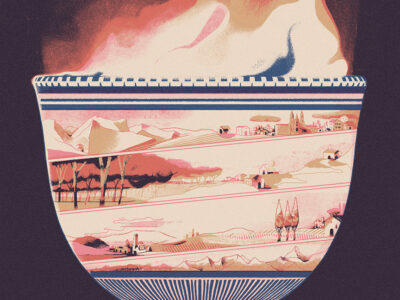
Good versus evil in Mexico City.
BY ST. JOHN BARNED-SMITH
It took only a minute or two in the crowded, chilly Mexico City evening to find a scalper with tickets for the match. “You’re going to enjoy it a lot,” an Uber driver had assured me and my friends, moments before dropping us among a throng of locals and tourists eager for a night of wrestling. The swarm swallowed us, and soon we were threading our way into lucha libre’s famed cathedral of violence, Arena Mexico.
Floodlights flashed. Fog filled the air. Cheers echoed all around as 18,000 spectators urged on four masked luchadors in the arena below us.
In the arena, a flyer promised an Espectacular Encuentro Estelar, with seven matches spanning three hours. We picked our way through the popcorn-strewn aisles, dispensed a tip to a surly ticket-taker, and settled into the hard, wooden bleacher seating to take in the undercard, which pitted the heroically named “Triton” and “Pegasus” against the likes of “Virus” and “Aztec Blood.”
I soon learned luchadors tend to divide into two camps, the técnicos, or “technicians,” and the rudos, or “heels.” If there are “good guys” in lucha libre, it’s the técnicos, who adhere to a strict code of honor, and for whom an unmasking represents a mortal wound to their honor. Rudos, meanwhile, are the lovable villains, willing to do whatever it takes to win, from underhanded moves to brown-nosing the referees.
At the outset of each match the luchadors strode out of a tunnel, down a long ramp, threading past a line of six dancers, and into the ring. Their costumes were as colorful and varied as their names, with bright, glittering capes and masks. Some dressed like devils, others like angels. They bumped chests and played to the crowd, each seeking larger cheers.
Then they fought: locking and clashing, tossing each other across the ring in ever more gravity-defying moves.
At times, the stunts—and the wrestlers’ dramatic displays—strained credulity.
“They just look like they’re dancing,” one of my friends scoffed, as two contestants circled each other.
Yet other times, the moves looked downright perilous, as wrestlers crashed full force onto the mat, sending echoes of the impact through the crowd.
The spectacle has captivated people here for more than 70 years, ever since a man named Salvador Lutteroth founded the Empresa Mexicana de Lucha Libre in 1933 and began holding matches in Mexico City.
A cottage film industry and national broadcast of matches propelled the sport’s growth and mass appeal, according to Heather Levi, author of The World of Lucha Libre: Secrets, Revelations, and Mexican National Identity .
Now, crowds flood the Colonia Doctores neighborhood weekly to attend matches at the city’s two largest lucha libre stadiums, Arena Mexico and the Coliseo. What began as a free-ranging battle royale has become a campy, vampy spectacle as beloved by tourists as by Mexican families and wrestling fanatics.
Over the years, some fighters have become near national heroes, featured in comic books and movies. The most prominent was probably Rodolfo Guzmán Huerta, who wrestled under the pseudonym “El Santo Enmascarado de Plata” (The Silver Masked Saint), and over the decades became an international icon.
Part of his appeal was the cult of mystery he built around his identity. El Santo was “obsessively careful,” in Levi’s words, about not revealing who he was—even when he was traveling abroad for international matches.
“When he got to the border, he would have a customs agent take him into a private room where he could take off his mask and show his passport there. That was the folklore around El Santo.”
For five decades, El Santo wrestled in stadiums and on the silver screen, and only revealed his identity a few days before his death.
Though El Santo died in 1983, and his nemesis, Blue Demon, passed away in 2000, their names live on in the ring; their descendants have taken up their identity and costumes. Now, lucha libre is a family business, as fighters square off the in the ring bearing the names and costumes of their parents or even grandparents, giving the wrestlers’ legends a sense of near-immortality.
While generations of Mexicans have relished lucha libre’s campy, ritualized violence-as-entertainment, life outside the ring has recently grown more perilous and more sobering. Mexicans have dealt with cartel violence for decades, but the last few years have brought a worrying surge in homicides—one that authorities have been unable to stem.
Back in Arena Mexico, merchants strolled through the crowd, hawking lucha libre dolls, Top Ramen, masks, or overflowing cups of Corona beer as the wrestlers below abused each other with joyous abandon.
In the row in front of us, three girls in pink masks snacked on Doritos and popcorn, watching as the fighters launched into “Huracarranas” and other holds that always seemed to end with the grapplers entwined like pretzels, one on top, the other flopping and twitching like a fish stranded out of water.
“It’s made for children mainly, which is incredible, because it’s violent,” I was told by Jesus Cruzvillegas, a 39-year-old local luchas fanatic kind enough to educate me about the sport. “But the most important public is the children. [As children], we play like luchadors.”
In contrast to popular wrestling in the US, the fighters before us didn’t talk much. Nevertheless, they still managed to communicate with their audience—using their whole bodies, since masks concealed their faces.
In the penultimate fight, Marco Corleone, an American who has wrestled professionally in the States but found greater success in Mexico—once being named “Best Body in Mexico”— wandered into the ring in a shiny pink and black Speedo, gyrating his hips at an approving (and bemused) crowd.
Corleone, along with his teammates Stuka and Angel de Oro (Gold Angel), squared off against Shocker, Terrible, and Rey Bucanero (Buccaneer King).
The técnicos won the first round, but in the second match they seemed to flag, losing to the Buccaneer King and his nefarious cronies, as the fickle fans screamed in disappointment.
Then Corleone and his team woke up, dropping frankensteiners, cross body blocks, and suicides on their villainous opponents. In a final climax, Angel de Oro and Stuka held one of the rudos against the ropes, while Corleone stepped out of the ring and walked up the entrance ramp from which they’d emerged at the start of the match.
After a dozen steps, he turned around and sprinted back towards the action. Then he launched into the air feet first, and slammed into his opponent’s rear like a missile, throwing the fighter halfway across the ring.
The bell rang a few moments later. The ref called it; the rudos were done. Sometimes, even in the rough-and-tumble of Mexico City, the good guys win.
St. John Barned-Smith C’08 is a reporter at the Houston Chronicle.




